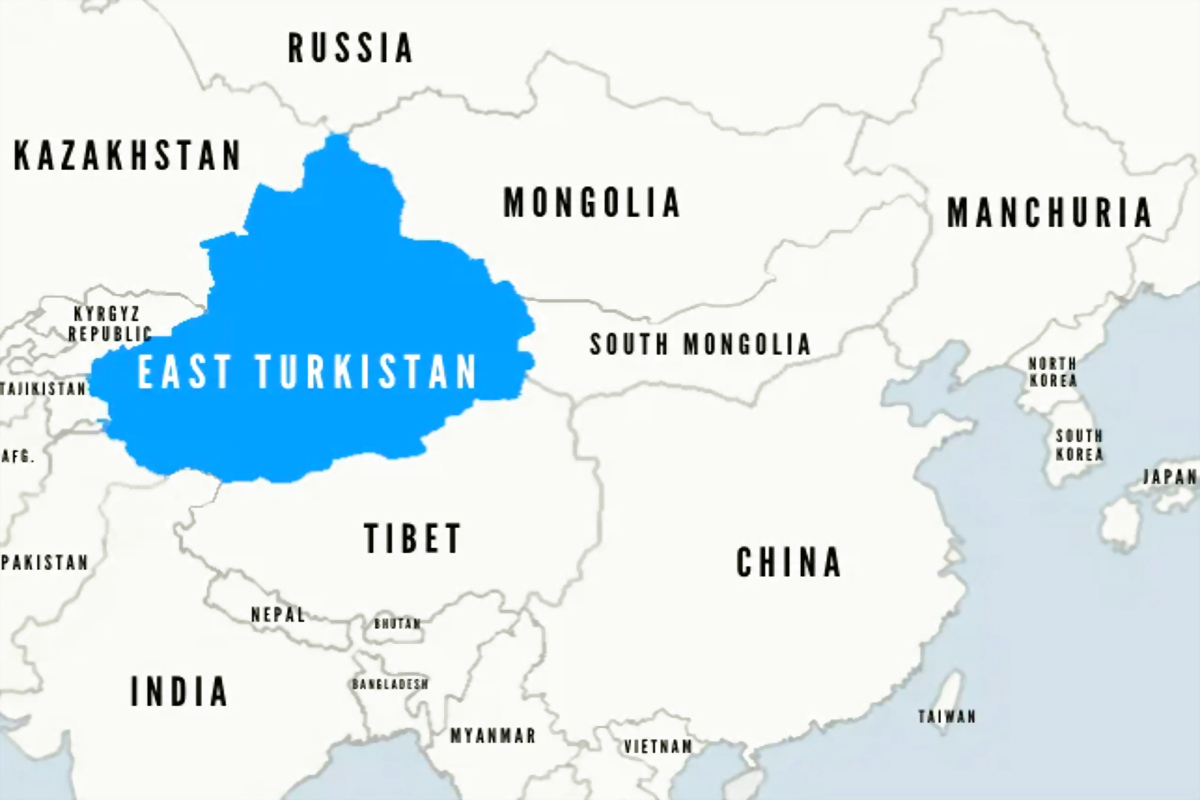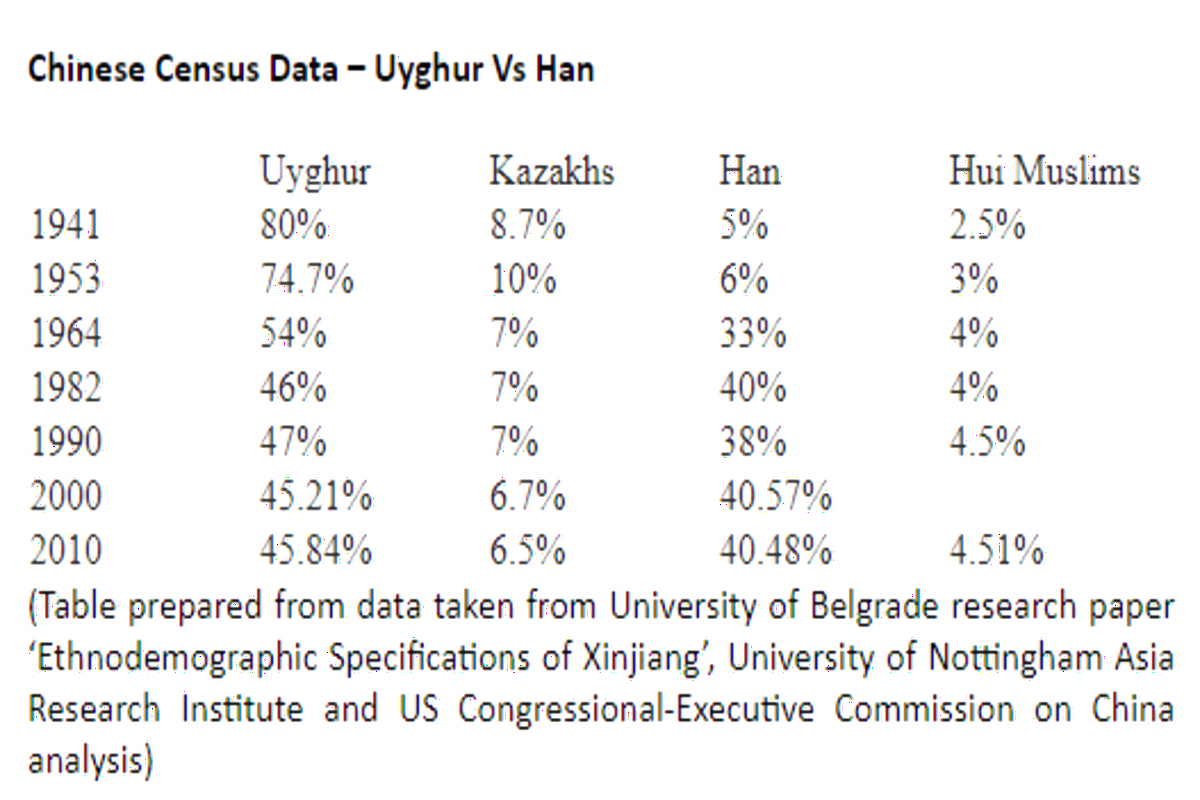
views
The Xinjiang Uyghur Autonomous Region (XUAR) is China’s largest administrative region in northwestern territory. It shares a border with eight countries along with India and central Asian nations of Kazakhstan, Kyrgyzstan and Tajikistan. Uyghur Muslims used to be the main native population group of Xinxiang, along with other small ethnic groups like Hui (Chinese Muslims) Kazakhs, Uzbeks, Tajiks, Tatars, Tahurs and Russians. But with mass-migration, the Han Chinese people, the main Chinese ethnic group, are now the second largest population group in Xinjiang.
According to the State Council Information Office of China, Xinjiang’s population in 2014 was 23.2 million. According to 2010 Census, Uyghur Muslims were 46% of the population, so we can reach an estimated figure of 10.67 million of Uyghur Muslims as per 2014 estimates. The 2010 Census put the Han Chinese count at 40%. Besides Xinjiang, Kazakhstan, Kyrgyzstan and Uzbekistan have also large communities of Uyghur Muslims. When China forcefully occupied Xinjiang in 1949, Han Chinese population share in the territory was just 6.7%. The last section of this article deals with mass influx on Han Chinese people in Xinjiang where the data has been compiled in a tabular form.
The Uyghur population is basically concentrated in southern Xinjiang. With agriculture their primary means of survival, they mostly inhabit rural areas. Just 4.3% of Xinjiang is inhabitable — the rest is spread across deserts and snow-capped glaciers. China’s largest desert Taklamakan is in Xinjiang.
Map of Xinjiang represented as ‘East Turkistan’ by the East Turkistan government in exile

(Image courtesy: https://east-turkistan.net/east-turkistan-at-a-glance/)
THE CHINESE SEIZE
Historically, an independent territory which saw colonization and independent struggles with different Chinese and Mongol dynasties, the brief of which is given in first part of this series, the East Turkistan nation, as the independent activist call it, has been subjected to permanent colonization since 1949 by a country that is ethnically, religiously, linguistically and culturally an alien.
A nation with a Muslim majority population is ruled by its neighbor, the People’s Republic of China that officially doesn’t believe in religion and sees Uyghur Muslims as extremists.
Islam is an integral part of Uyghur lives. They identify themselves with the central Asian nations in religion, language, culture and identity. In fact, Islam is the root cause of their desire to become an independent nation, and so there are extremists for a dictatorial Chinese government.
The racial discrimination against Uyghur Muslims increased especially after the racial violence of 2009 in Xinjiang capital Urumqi that killed over 200 people. China claims most victims were the Han Chinese people.
How China has crushed the Uyghur movement
Chinese President Xi Jinping’s stern message in 2014 was – ‘Show absolutely no mercy on Uyghur people’, control their violence, transform them and keep them under surveillance for life.’
This is the crux of what Xi thinks to control the Uyghur unrest, as revealed from a document released by someone from the Chinese political establishment to the New York Times. Mass detain them, suppress their Islamic identity, reduce their absolute numbers by bringing down fertility levels and keep them under continuous surveillance.
China started crackdown on Uyghur Muslims after the collapse of USSR and emergence of Central Asian Nations fearing it will push the desire for independence even more among Uyghur Muslims. Xi Jinping has only exacerbated it, to its final solution level. China has made Uyghur Muslims a second class citizen. They cannot practice religion. They are forced to weather social and economic discrimination. They are mass interned to kill so that their voices and aspiration can be killed.
Xinjiang is an exact replica of the excess being done by China in Tibet, something that is explained in the next article of this series. First capture the nation. Then sinicise its religion. If that fails then demographically cleanse them through stringent birth control measures, mass internment and, simultaneously, use them as forced labour in Chinese industries.
Sinicise Islam — If you are religious the way Muslims are, you are an extremist
The first step is to target them on their religious adherence. In 2015, Xi said five religions, Islam, Buddhism, Daoism, Catholicism and Protestantism, must be sinicised. But we know the main focus obviously has been on Buddhism and Islam, religions of the two independent nations that China has occupied.
China says sinicisation of religion means making it compatible with socialist core values, to make it in sync with the socialist society. It says it does not want to change the ideology, Islamic belief system and habits.
But what China does, is totally against it.
In January 2019, China passed a law, an outline to sinicise Islam in five years, from 2018 to 2022, but by then world community had already come to know true intent with revelation in 2017 of Xinjiang’s mass internment camps. Mass internment camps may have existed even before that as some reports point out. And while over a million Uyghur and other ethnic Muslims are incarcerated in internment camps, China says ‘sinicisation of Islam’ has matured since it was put forward as a concept by Jinping in 2015.
Six months later, in July 2019, China came up with a theory that Uyghur Muslims in Xinjiang were basically, historically and originally Chinese people who were forced to become Muslims by the Arab invaders. Chinese government’s propaganda arm, China’s State Council Information Office, released a white paper on this claim. The paper claimed Uyghur Muslims have been part of China for thousands of years and says ‘Islam is neither an indigenous nor the sole belief system of the Uyghur people’.
So, even if Islam spread in the territory 8th century onwards and is it is lifeline of Uyghur Muslims now, China claims Islam is not indigenous in the Xinjiang province. So, Islam that saw its origin in 7th century CE and is the world’s second largest religion now cannot be a righteous cause in a Chinese province that seeks its independence, because China doesn’t think so.
We can say before 7th century CE, there were no Muslims or followers of Islam but can that be a valid reason to say Islam is not indigenous in a Chinese territory or anywhere else despite being the main religion for over 1200 years now? Pakistan and Bangladesh were parts of India and now are Islamic nations but India has never claimed that these nations are Indian territories.
But China, it seems, believes in that. What it is doing in Xinjiang tells us that. Obviously, for China, land is above the world’s second largest religion here.
China has banned most Islamic religious practices. Uyghur Muslims cannot keep Ramadan fast. An investigative report from British newspaper The Telegraph from Kashgar, a Xinjiang city, says how Chinese authorities forced Muslims to eat and drink during the Ramadan fast days. Pork is strictly prohibited in Islam but Chinese authorities forced Muslims to eat pork and drink alcohol during a Chinese festival, a report from US-funded Radio Free Asia says.
Uyghur Muslims are not allowed to name their children with religious words like Muhammad or Islam or Jihad or Quran or Mecca. China even wants to sinicise the Uyghur Muslim homes. They are forced to modernize their homes with Chinese style furnishings and those who do not follow the directive are called religious extremists and locked up in mass internment camps. Uyghur and other ethnic Muslims in Xinjiang are under continuous state instruction and surveillance to follow directives, issued from time to time, and a simple violation forces them to a mass internment camp.
Another big shock to the religious practices to the Uyghur Muslims is the massive destruction of their religious places under Xi’s hardliner policy. Critics call China a bulldozer state for its mosque rectification drive in China.
According to a report from Radio Free Asia, Chinese authorities have so far destroyed 70% mosques in the region. Another report, using geo-location technique, from the Washington-based Uyghur Human Rights Project (UHRP) says China destroyed 10,000 to 15,000 Uyghur mosques and religious places between 2016 and 2019.
A latest investigative report from Australian Strategic Policy Institute (ASPI), using satellite imagery and night-time satellite imagery, says 65% or 16,000 mosques in the region are either totally destroyed or significantly damaged. ASPI report further adds that since 2017, “30% of important Islamic cultural sites (sacred shrines, cemeteries and pilgrimage routes) have been demolished, with an additional 28% damaged or altered in some way”.
And these numbers do not look exaggerated. According to a report from the British daily The Guardian, 200 mosques were destroyed in 2017 and 500 more mosques were to be destroyed in 2018 in the eastern region of Qumul in Xinjiang, just in one prefecture-level city. The Chinese Communist Party has ordered to remove all Islamic religious symbols from the Uyghur places of worship, a report from the Voice of America says.
According to a report from the human rights group Amnesty International, China has clamped down on Uyghur Muslims’ ‘peaceful expression of cultural identity’. Another human rights group the Human Rights Watch adds that China has stepped up persecution of Uyghur people with prohibitions on Islam in Xinjiang.
Demographical cleansing
The second step is to cleanse them demographically. Contain them in mass internment camps. Do mass sterilizations. Use them as forced labour. Lock them up: How many Uyghur and other Muslim minorities are in mass internment camps? Different investigative reports may put different numbers one thing is common, the base figure runs in millions.
In August 2018, the U.N. Committee on the Elimination of Racial Discrimination said that estimated 2 million Uyghur and Muslim minorities were forced into mass internment camps so far. The UN Committee estimation was based numerous reports that it said were credible. 2017 was the year when mass internment camps were revealed to be operational in Xinjiang and the Chinese province saw 21% of all Chinese arrests made that year.
According to ASPI’s latest investigative report, over a million Uyghur and other Turkic and Muslim minorities are locked up in 380 detention camps. The ASPI report contradicts the Chinese claims that it is winding up the process. 61 such camps were expanded between July 2019 and July 2020 and 14 are still growing, satellite images confirm.
Gulags, what else! A recent report in the British daily The Sun paints even a darker picture. The daily, quoting a leaked document from Beijing says mass internment camps existed even in 2014 and till date, eight million Uyghur and other Muslim minorities could have been forced through the camps or gulags. Gulag network was a series of forced labour camp in the Soviet Union from 1920s to mid-1950s and imprisoned millions of people.
US House of Representatives recently passed a legislation that proposes to ban imports from Xinjiang over forced labour camps. That is another aspect of the mass detention camps being run by China. In July this year, opposing forced labour in Xinjiang, more than 190 human rights groups from 36 countries gave a call to the international clothing brands to stop garment import from Xinjiang in next 12 months. 20% of cotton or yarn supply globally is from Xinjiang.
In March this year, ASPI published a report, Uyghurs for sale that said 80,000 Uyghur workers were sent to industrial units in different provinces in China. They ended up in low factory jobs. The report identified 83 foreign and Chinese companies using the Xinjiang forced labour. According to CSIS brief, the Xinjiang forced labour is ‘severally underpaid’.
Unwanted! That looks exactly the Chinese motive. China is targeting mass internment camps and Uyghur dominating reasons with stringent birth control measures. Chinese law for ethnic minorities earlier allowed them to have two children and rural ethnic minorities could have up to three children even when while China was following the ‘one-child’ policy nationally.
But now after relaxing the one-child policy nationally and encouraging the Han Chinese people, mass migrated to Xinjiang, to have more than one child, China is forcing the reproductive age Uyghur women to go through stringent birth control measures including drug use and sterilisations.
An investigative research study by Adrian Zenz, a Chinese scholar, who has published his with the Jamestown Foundation, gives us some eye-opening figures. According to his research work, 1.8 million minorities are in mass internment camps and birth-control violation is a major factor for the extrajudicial internment.
Zenz’s work shows Xinjiang’s natural population growth rate plummeted in 2018. Kashgar and Hotan, two largest Uyghur prefectures saw their natural population growth rate decline by 84% between 2015 and 2018. Some Uyghur counties saw more deaths than birth. China, by 2019, had planned to sterilize 80% women of childbearing age in four Uyghur dominated minority areas, the report added.
According to an investigation by the Associated Press, while the use of intrauterine device (IUD) to prevent pregnancy fell sharply in China, it witnessed a massive increase in Xinjiang. Zenz’s research says, in 2018, 80% of China’s IUD placements happened in Xinjiang, a province that contains just 1.8% of China’s total population. The sterilization surgery saw seven-fold rise in Xinjiang’s Uyghur dominated areas while its rate nationally came down.
Between 2018 and 2019, the birth rate in Xinjiang declined by 24% in 2019 while nationally it saw a decline of just 4.2%. It saw a sharp decline in ethnic minority regions, in the range of 30 to 56%. Zenz says China has stopped publishing the latest updates on birth rates from Uyghur dominated regions.
Add to it another level of discrimination: An independent tribunal in London, China Tribunal, working to stop organ transplant abuse by China, says China has been involved in organ harvesting from dissidents and people interned in detention camps. While the main target has been the Falun Gong practitioners, a spiritual cult that once had more followers than the total number of Chinese Communist Party members, other ethnic minority groups including Uyghur Muslims are now being increasingly targeted, the Tribunal said to the UN Human Rights Council in Geneva in September 2019.
According to a US Government House Hearing report, 65,000 Falun Gong members were killed for organ harvesting in China. Although the hearing report is from 2012, this number is still widely used globally and the real, current figure could be much higher with China now forcing its ethnic minorities, Uyghur Muslims and Tibetans, in mass internment camps.
Mass influx of Han Chinese
The Chinese Uyghur breakdown machinery has aligned itself with demographic invasion of Han Chinese people from other part of China to Xinjiang territory. According to Xinjiang Uyghur Autonomous Region statistical yearbook, Han Chinese population in Xinjiang was 6.7% in 1949 which increased to 40.48% according to Chinese Census 2010. Uyghur Muslims were 80% of the Xinjiang population in 1941 and around 76% in 1949. They have seen a consistent decline with Kazakh Muslim and were reduced to 45.84% in 2010.
Chinese Census Data – Uyghur Vs Han

Uyghur Muslims who once defined the Xinjiang region are now just slightly more than the Han Chinese people in Xinjiang province as per the figures of Chinese Census 2010 and if we go by the recent trends after 2009 Xinjiang violence with emergence of mass internment camps, birth prevention measures and Uyghur Muslims being used as forced labour across China, the next Chinese Census may show some surprising data (if it is made public). We may see more Han Chinese people in Xinjiang that Uyghur Muslims in near future.
Adrian Zenz’s research shows how China is increasing Han settler colonialism in Xinjiang in recent years. 863,000 Han Chinese left Xinjiang between 2015 and 2018 but 2.03 million new residents were added as well to the Han majority reasons in Xinjiang during the same period.
(The next article in the series focuses on Chinese atrocities in Tibet.)
Read all the Latest News and Breaking News here
















Comments
0 comment